Upper Mustang, also known as the “Forbidden Kingdom,” which is close to Tibetan plateau so it is crucial to understand the Upper Mustang Permit requirements that govern access to this restricted area.
Upper Mustang is consider as hidden gem that offers a captivating blend of ancient Tibetan culture and breathtaking landscapes.
Who needs a Upper Mustang Permit?
A Upper Mustang Permit is obliged for all non-Nepali people. To enter this area the permits mentioned below are needed, these will be checked at checkpoints. Nepali citizens do not require permits to enter Upper Mustang.
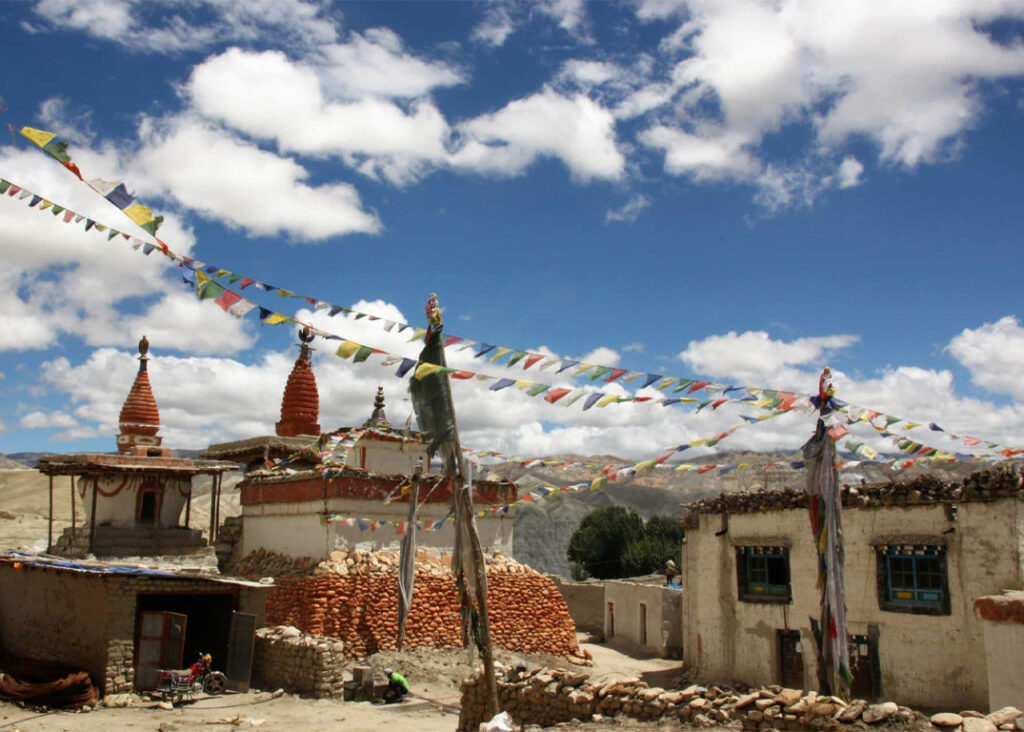
The permit requirements mentioned in the blog post are specifically for foreigners or non-Nepali residents who wish to visit Upper Mustang. Nepali citizens have unrestricted access to Upper Mustang and can travel there without obtaining any special permits.
However, they may still need to show identification documents while passing through checkpoints along the trekking route.
What do you need to get the Upper Mustang Permit?
- Your passport with a valid visa
- A copy of your passport and visa
- A passport-size photo
- Cash money, either Nepali Rupees or USD
Upper Mustang Permit Needed
Restricted Area Permit (RAP)
Upper Mustang is a restricted region in Nepal, and all travelers must obtain a special permit to enter. The Restricted Area Permit (RAP) is a mandatory requirement for foreigners and is designed to regulate tourism and preserve the region’s cultural heritage. To acquire the RAP, you must be accompanied by a registered trekking agency or a licensed trekking guide.
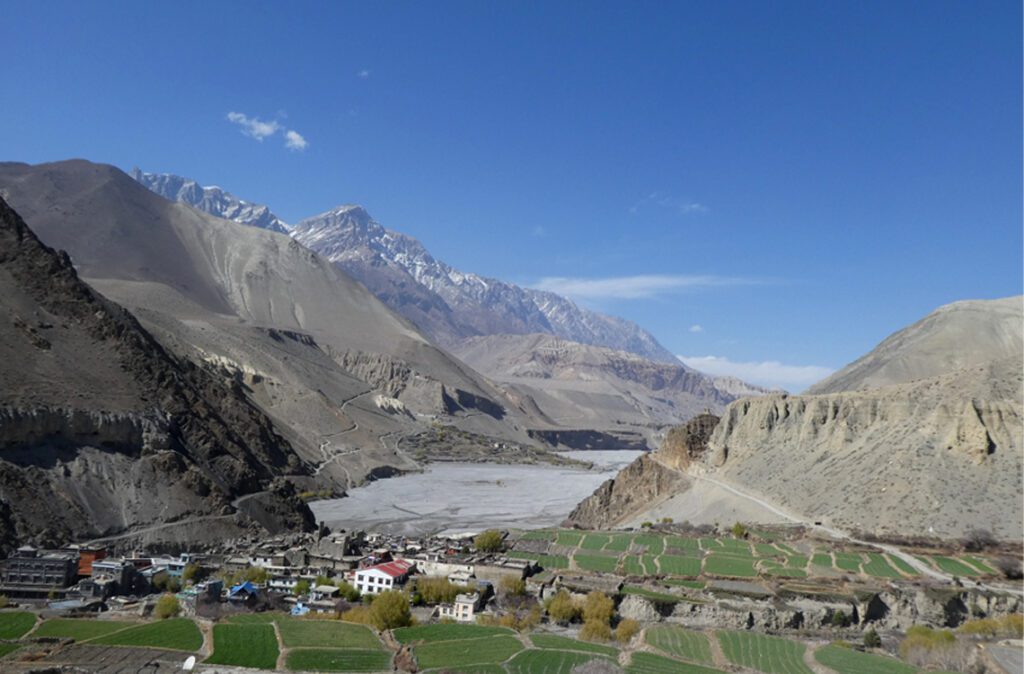
This permit is $500 per person for 10 days. After this, it costs $50 a day per person to extend this permit. This permit starts at Kagbeni and ends at Kagbeni village of Mustang.
Note: it is not possible to obtain the RAP permit yourself.
Annapurna Conservation Area Project (ACAP)
The Annapurna Conservation Area Project (ACAP) is another essential permit for Upper Mustang trekkers. ACAP aims to conserve the natural environment and sustain local communities within the Annapurna Conservation Area. Since Upper Mustang falls within this region, you need to obtain an ACAP in addition to the RAP. ACAPs can be obtained at the Nepal Tourism Board’s office in Kathmandu or in Pokhara.

This permit costs $20 or NPR 2260 per person for a one-time entry in the upper Mustang area. However, people that have a nationality from a SAARC country only have to pay NPR 226.
This permit has no limit of days, it will be valid for as long as your trekking takes.
TIMS Card
The Trekker’s Information Management System (TIMS) card is a prerequisite for all trekkers visiting Nepal, regardless of the region. TIMS cards serve as a database for trekking activities and provide essential information for search and rescue operations. However, when you only go to the upper Mustang area this permit is not necessary.
This is because the RAP is already sufficient enough to register details of you as a trekker. To obtain a TIMS card, you need to register with the Trekking Agencies Association of Nepal (TAAN) or the Nepal Tourism Board. Your trekking agency can assist you with the TIMS card application.
Special permits for Mustang’s southern route
If you plan to trek to Upper Mustang via the southern route (from Kagbeni to Muktinath), you will require an additional permit. The “Mustang Special Trekking Permit” is needed to access this particular route, which offers a distinct cultural and geographical experience.
You may also like: Upper Mustang Trek Cost: Permits, Expenses, and More
This permit can be obtained at the Nepal Tourism Board or the Annapurna Conservation Area Project (ACAP) office in Kathmandu or Pokhara.
How to obtain the permits
The ACAP, TIMS, and other special permits can easily be obtained by yourself at the Nepal Tourism Boards in Kathmandu or the Tourist Office in Pokhara.
However, it is not allowed to trek alone in the upper Mustang area. It is therefore also not possible to obtain the RAP permit yourself. Also, individual guides cannot obtain this permit, only a trekking company registered in Nepal can get this.
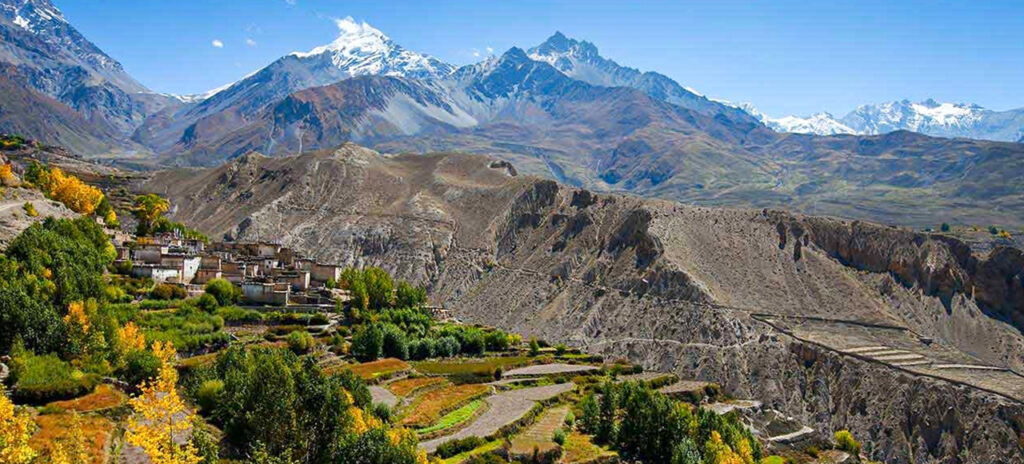
To simplify the permit process and ensure compliance with local regulations, it is highly recommended to hire a registered trekking agency. These agencies have the necessary expertise and experience to assist you in obtaining the appropriate permits and guide you through the Upper Mustang trek.
Highlights of Upper Mustang
The Upper Mustang trek is renowned for its unique cultural heritage, stunning landscapes, and remote beauty. Here are some of the highlights you can expect while trekking through Upper Mustang:
Forbidden Kingdom Experience
Upper Mustang was once a forbidden kingdom, isolated from the outside world for centuries. As you explore the region, you’ll have the opportunity to witness the preserved Tibetan Buddhist culture and traditions that have remained intact over time.
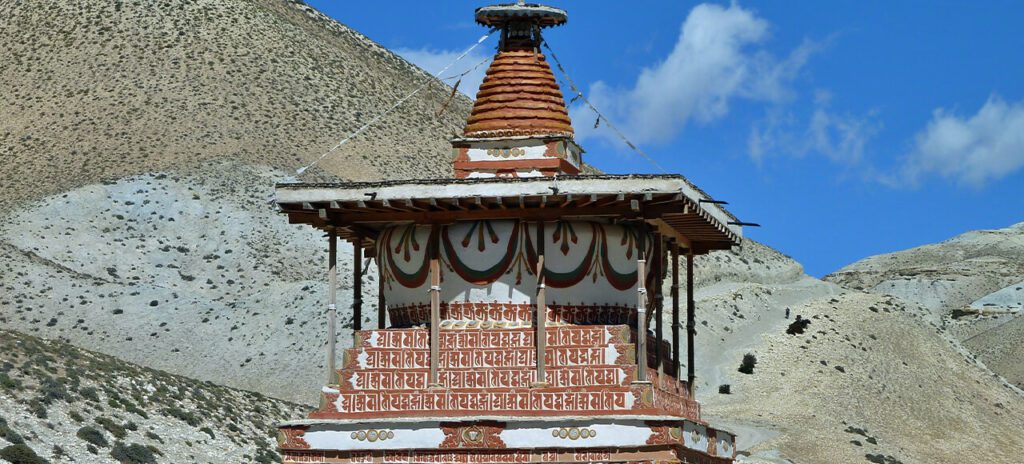
The ancient monasteries, Chortens (Buddhist shrines), prayer flags, and intricate murals will transport you to a bygone era.
Lo Manthang
The capital of the former Mustang Kingdom, Lo Manthang, is a major highlight of the trek. Enclosed by walls, this ancient city offers a glimpse into a medieval Tibetan town.

You can wander through narrow alleys, visit the royal palace, and interact with the warm-hearted locals to learn about their way of life.
Dramatic Landscapes
Upper Mustang showcases a unique landscape characterized by arid, desert-like terrain, deep canyons, and towering cliffs. The striking red and ocher rock formations, carved by centuries of wind and water erosion, create a surreal atmosphere.
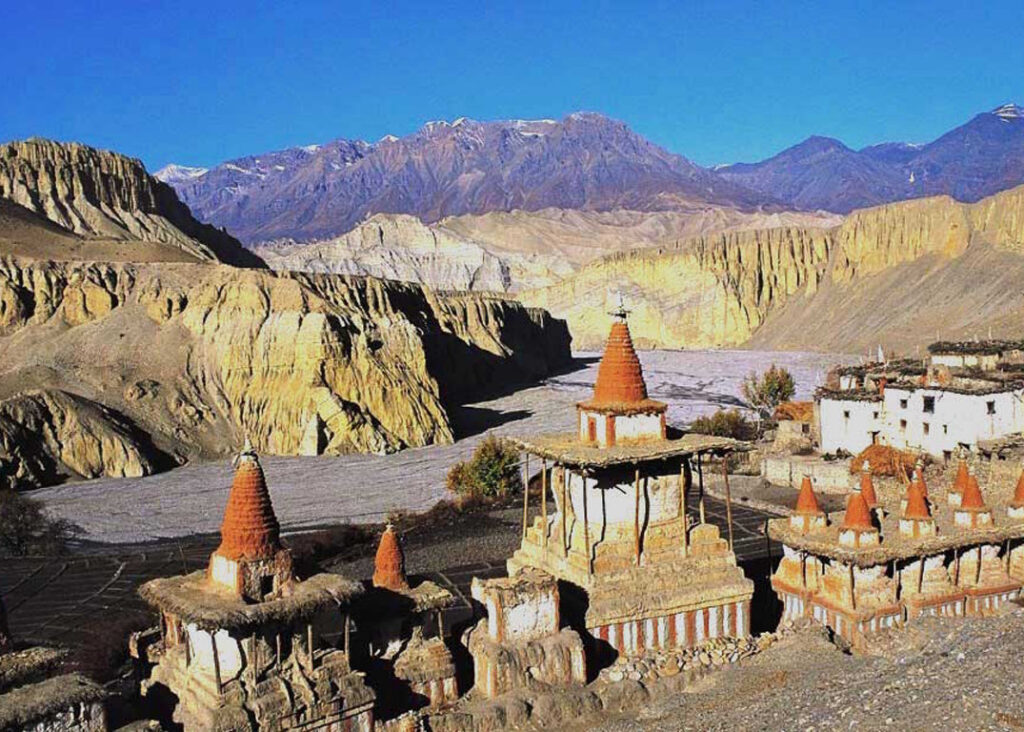
You’ll also encounter scenic valleys, barren plateaus, and occasional green patches near rivers and villages.
Kagbeni
The starting point of the Upper Mustang trek, Kagbeni, is a picturesque village located at the confluence of the Kali Gandaki and Mustang rivers. This ancient trading post offers a glimpse into traditional Mustangi architecture and culture.
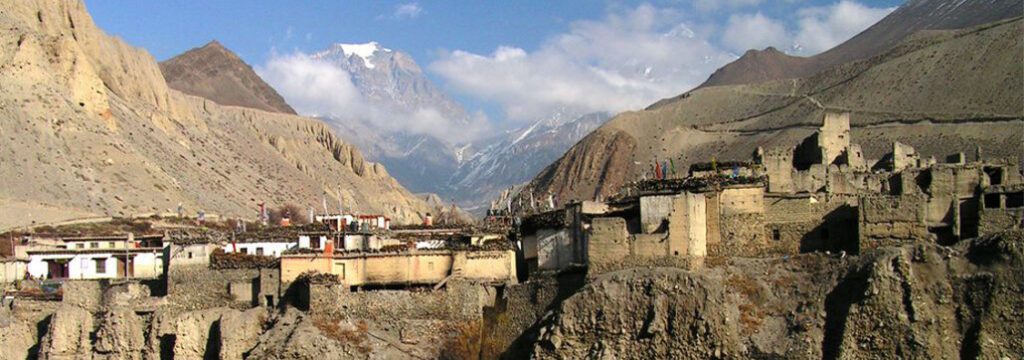
The views of the surrounding mountains and the iconic Kagbeni monastery add to the charm of this village.
Stunning Monasteries
Upper Mustang is dotted with impressive monasteries that serve as spiritual centers for the local community. The Thubchen Gompa, Chhoser Cave Monastery, and Ghar Gompa are among the notable monastic sites you can visit along the trek.
Also Read: Tengboche Monastery: The oldest monastery in Khumbu
These monasteries feature stunning murals, and intricate woodwork, and offer a serene ambiance for meditation and reflection.
Hidden Caves and Caves Dwellings
Upper Mustang is known for its intriguing cave dwellings, carved into the cliffs by ancient inhabitants. These caves served as homes, monasteries, and storage areas. Exploring these hidden caves provides a unique insight into the historical and cultural significance of the region.
Panoramic Mountain Views
Throughout the trek, you’ll be treated to breathtaking mountain vistas. The snow-capped peaks of the Annapurna and Dhaulagiri ranges form a stunning backdrop to the arid landscapes.

The views of Nilgiri, Tukuche, and Thorong Peak are particularly awe-inspiring.
Ghami and Charang Villages
The charming villages of Ghami and Charang are worth visiting during the trek. Ghami is known for its whitewashed houses, maze-like alleys, and the ancient Ghami Monastery. Charang, on the other hand, is famous for its red-walled fortress-like monastery, which houses a large collection of statues and religious artifacts.
Lo La Pass
The trek includes crossing the Lo La Pass, which stands at an elevation of approximately 3,950 meters (12,960 feet).
More: Upper Mustang Festival: An Spiritual Heaven
The pass offers breathtaking panoramic views of the surrounding mountains and valleys, making it a memorable and rewarding part of the journey.
Tiji Festival
If you time your visit right, you may have the opportunity to witness the vibrant Tiji Festival in Lo Manthang.
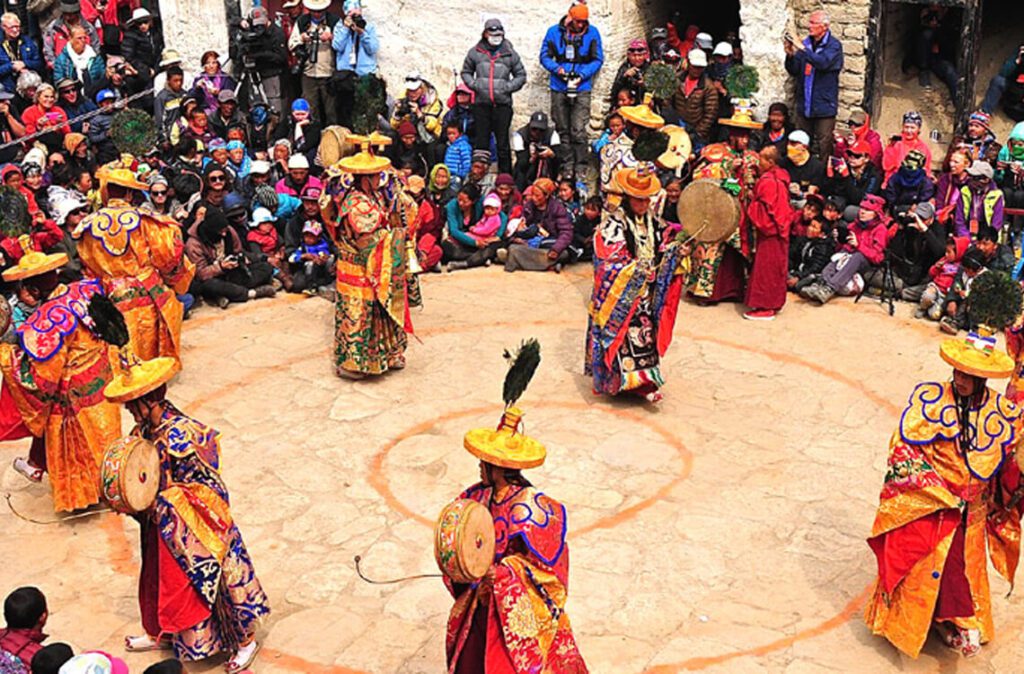
This three-day festival celebrates the triumph of good over evil and features masked dances, cultural performances, and religious rituals. It offers a unique glimpse into the religious and cultural practices of the region.
Scenic Flights
As an alternative or complementary experience to trekking, you can opt for a scenic flight to Upper Mustang. The flight provides a bird’s-eye view of the Mustang region, allowing you to admire its rugged beauty and appreciate the vastness of the Himalayan landscape.
Weather in Upper Mustang
September to November (Autumn)
Autumn is considered the best time to visit Upper Mustang. The weather is generally stable and pleasant, with clear skies and mild temperatures. September marks the end of the monsoon season, so the landscape is lush and green. As the season progresses, temperatures gradually start to drop, especially in November.
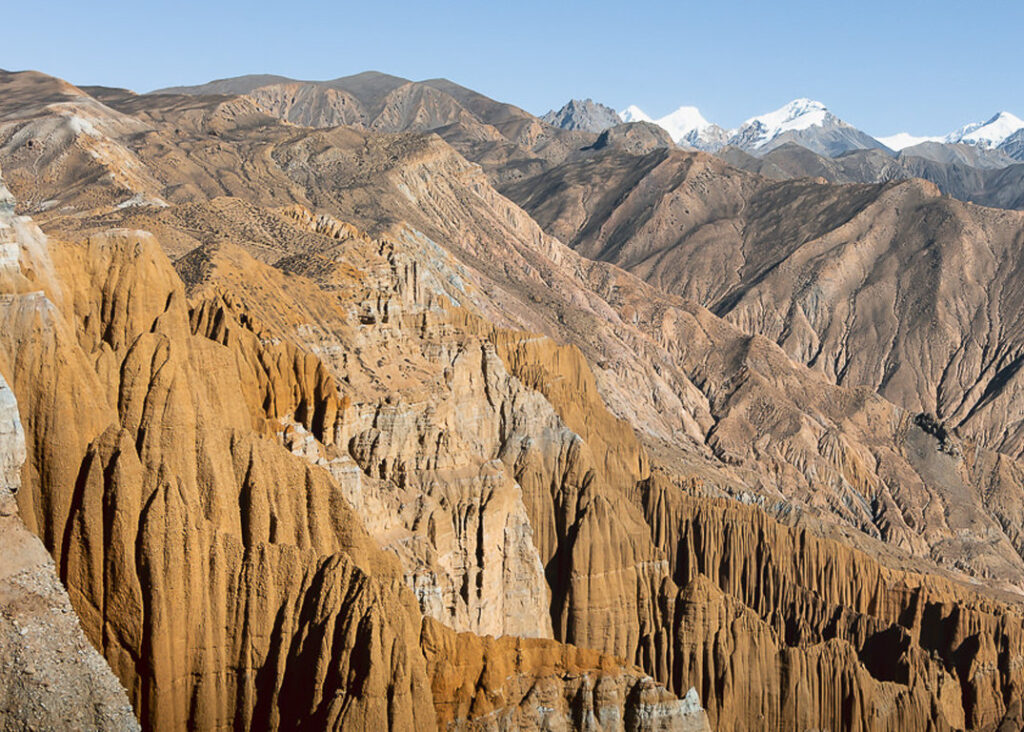
Daytime temperatures range from 15°C to 20°C (59°F to 68°F) in September and can drop to 5°C to 10°C (41°F to 50°F) in November. Nights can get chilly, with temperatures ranging from 0°C to 5°C (32°F to 41°F).
December to February (Winter)
Winter in Upper Mustang brings cold temperatures and occasional snowfall. Daytime temperatures hover around 5°C to 10°C (41°F to 50°F) but can drop to below freezing at higher altitudes.

Nights are extremely cold, with temperatures dropping to -10°C to -20°C (14°F to -4°F) or even lower. The trekking trails may be icy and challenging, and some guesthouses and facilities may be closed due to the harsh conditions. Winter trekking in Upper Mustang requires proper cold-weather gear and experience in winter trekking.
March to May (Spring)
Spring is another favorable season for trekking in Upper Mustang. The weather gradually becomes warmer, and the landscape starts to bloom with rhododendrons and other wildflowers. March still has colder temperatures, ranging from 5°C to 15°C (41°F to 59°F), but by May, temperatures increase to 15°C to 20°C (59°F to 68°F) during the day.

Nights remain chilly, ranging from 0°C to 5°C (32°F to 41°F). Springtime offers clear skies and excellent visibility, making it ideal for enjoying stunning mountain vistas.
June to August (Monsoon)
The monsoon season brings heavy rainfall and high humidity to Upper Mustang. Treks during this time can be challenging due to slippery trails and increased leech activity. The rain can lead to landslides, which may affect trekking routes.

The temperatures during the monsoon season range from 15°C to 25°C (59°F to 77°F) during the day and can drop to 10°C to 15°C (50°F to 59°F) at night. It is advisable to exercise caution and plan accordingly if trekking during the monsoon season.
It’s important to note that weather patterns can vary, and unexpected weather changes can occur at any time. Checking the weather forecast before your trek and consulting with local authorities or experienced trekking agencies is recommended to stay updated on the current conditions and make informed decisions about your trekking plans.
Regardless of the season, it is crucial to pack appropriate clothing and gear to ensure comfort, safety, and enjoyment throughout your Upper Mustang trek.
Best time to travel to Upper Mustang
The best time to travel to Upper Mustang largely depends on personal preferences and the specific experiences you seek.
Popular: Best time to do Upper Mustang Trek
However, the most popular and recommended seasons for trekking in Upper Mustang are autumn (September to November) and spring (March to May). Here’s a breakdown of the advantages and considerations for each season:
Autumn (September to November)
Autumn is widely regarded as the best time to visit Upper Mustang. The weather is generally stable, with clear skies, minimal rainfall, and mild temperatures. The landscapes are lush and green after the monsoon season, offering a picturesque backdrop for your trek. The visibility is excellent, providing panoramic views of the surrounding mountains.

Autumn is also the peak trekking season in Nepal, including Upper Mustang, so you can expect a vibrant trekking atmosphere and opportunities to interact with fellow trekkers. It is advisable to make early bookings for accommodations and permits due to the high demand during this period.
Spring (March to May)
Spring is another favorable time to explore Upper Mustang. The weather gradually warms up, and the region bursts into colorful blooms with rhododendrons and wildflowers. The skies are generally clear, and the mountain views are stunning. Springtime offers comfortable temperatures during the day, making it pleasant for trekking.
Also Read: Upper Mustang Trek in March
However, you should be prepared for occasional showers, especially in the later part of spring. The trails may be slightly less crowded compared to autumn, allowing for a quieter and more peaceful trekking experience.
While autumn and spring are the preferred seasons, it’s important to consider your specific preferences and priorities. Here are some additional factors to keep in mind:
Winter (December to February)
Winter brings colder temperatures and occasional snowfall to Upper Mustang. The region becomes quieter, with fewer trekkers on the trails. The snowy landscapes can create a serene and magical ambiance, especially if you enjoy winter trekking and want to experience the region in a more secluded setting.
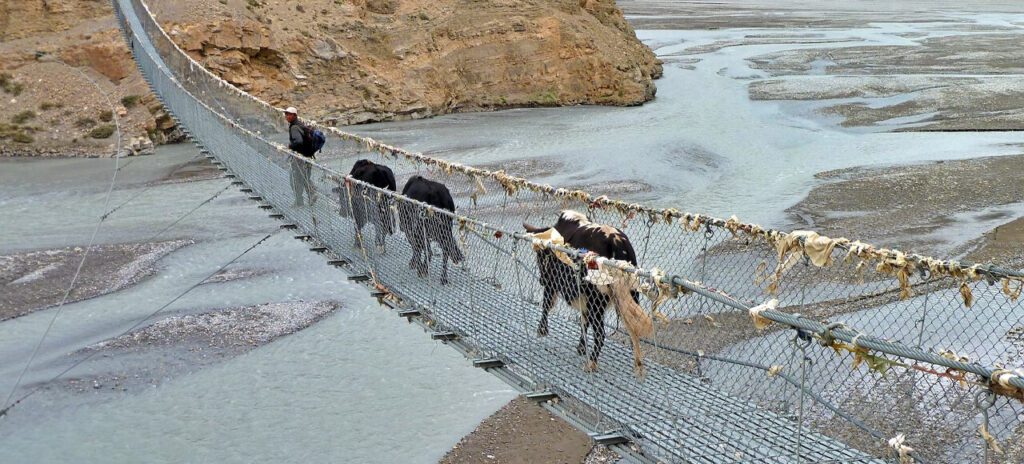
However, be prepared for cold temperatures, limited facilities, and potential trail closures due to heavy snowfall. Winter trekking requires proper equipment, experience, and a higher level of preparation.
Monsoon (June to August)
The monsoon season is characterized by heavy rainfall and high humidity. Trekking in Upper Mustang during this time can be challenging due to slippery trails and increased leech activity. However, the monsoon season also offers its own unique beauty, with the landscapes becoming lush and vibrant.
If you don’t mind the rain and prefer a quieter trekking experience, you can still consider visiting Upper Mustang during the monsoon. Just keep in mind the potential challenges and be prepared for the weather conditions.
Read: Upper Mustang Trek in June
Ultimately, the best time to travel to Upper Mustang depends on your personal preferences regarding weather, crowd levels, and the type of experience you seek. Regardless of the season, it is essential to pack appropriate clothing, and gear, and be prepared for the specific conditions you may encounter during your trek. Consulting with experienced trekking agencies or local authorities can provide valuable insights and help you make an informed decision based on the current conditions.







